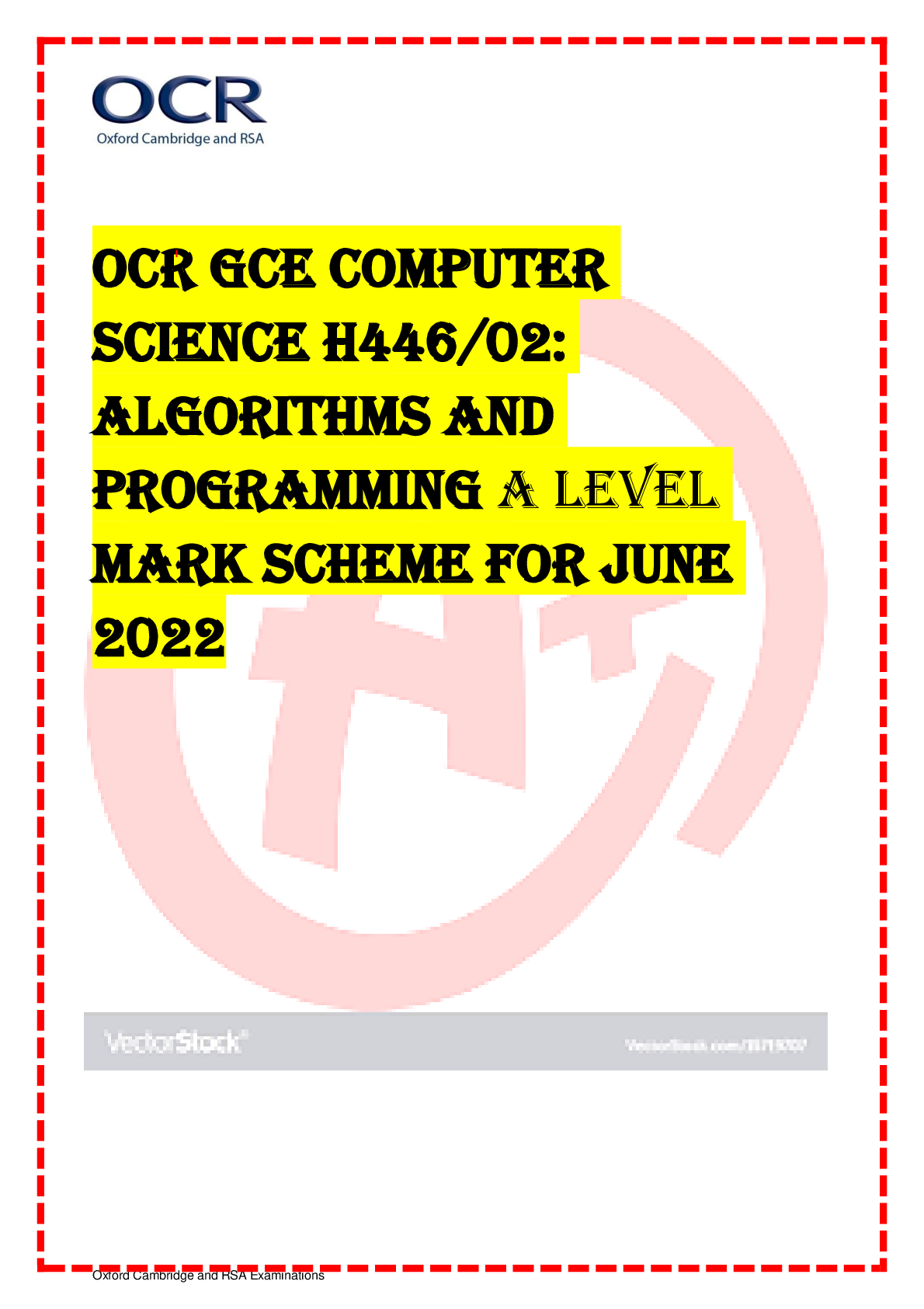Classical Civilisation > AS Mark Scheme > GCE Classical Civilisation H408/22: Imperial image Advanced GCE Mark Scheme for November 2020 (All)
GCE Classical Civilisation H408/22: Imperial image Advanced GCE Mark Scheme for November 2020
Document Content and Description Below
Oxford Cambridge and RSA Examinations GCE Classical Civilisation H408/22: Imperial image Advanced GCE Mark Scheme for November 2020Oxford Cambridge and RSA Examinations OCR (Oxford Cambridge and... RSA) is a leading UK awarding body, providing a wide range of qualifications to meet the needs of candidates of all ages and abilities. OCR qualifications include AS/A Levels, Diplomas, GCSEs, Cambridge Nationals, Cambridge Technicals, Functional Skills, Key Skills, Entry Level qualifications, NVQs and vocational qualifications in areas such as IT, business, languages, teaching/training, administration and secretarial skills. It is also responsible for developing new specifications to meet national requirements and the needs of students and teachers. OCR is a not-for-profit organisation; any surplus made is invested back into the establishment to help towards the development of qualifications and support, which keep pace with the changing needs of today’s society. This mark scheme is published as an aid to teachers and students, to indicate the requirements of the examination. It shows the basis on which marks were awarded by examiners. It does not indicate the details of the discussions which took place at an examiners’ meeting before marking commenced. All examiners are instructed that alternative correct answers and unexpected approaches in candidates’ scripts must be given marks that fairly reflect the relevant knowledge and skills demonstrated. Mark schemes should be read in conjunction with the published question papers and the report on the examination. © OCR 2020H408/22 Mark Scheme November 2020 2 Annotations Symbol Description Comment Tick worthy of credit ? unclear S error of spelling E error of grammar, punctuation or expression F error of fact ^ omission H Line to draw an attention to an error V Wavy Line to draw attention to something H Wavy Line to draw attention to something ……… Highlight as directed by PE REL irrelevant pointH408/22 Mark Scheme November 2020 3 REP conspicuous repetition L illegible word or phrase BP Blank Page – this annotation must be used on all blank pages within an answer booklet and on each page of an additional object where there is no candidate response. SUBJECT–SPECIFIC MARKING INSTRUCTIONS Introduction Your first task as an Examiner is to become thoroughly familiar with the material on which the examination depends. You should ensure that you have copies of these materials: • the specification, especially the assessment objectives • the question paper and its rubrics • the mark scheme. You should ensure also that you are familiar with the administrative procedures related to the marking process. These are set out in the OCR booklet Instructions for Examiners. If you are examining for the first time, please read carefully Appendix 5 Introduction to Script Marking: Notes for New Examiners. Please ask for help or guidance whenever you need it. Your first point of contact is your Team Leader. Information and instructions for examiners The co-ordination scripts provide you with examples of the standard of each band. The marks awarded for these scripts will have been agreed by the Team Leaders and will be discussed fully at the Examiners’ Co-ordination Meeting. The specific task-related indicative content for each question will help you to understand how the band descriptors may be applied. However, this indicative content does not constitute the mark scheme: it is material that candidates might use, grouped according to each assessment objective tested by the question. It is hoped that candidates will respond to questions in a variety of ways. Rigid demands for ‘what must be a good answer’ would lead to a distorted assessment. Candidates’ answers must be relevant to the question. Beware of prepared answers that do not show the candidate’s thought and which have not been adapted to the thrust of the question. Beware also of answers where candidates attempt to reproduce interpretations and concepts that they have been taught but have only partially understood.H408/22 Mark Scheme November 2020 4 Using the Mark Scheme Please study this Mark Scheme carefully. The Mark Scheme is an integral part of the process that begins with the setting of the question paper and ends with the awarding of grades. Question papers and Mark Schemes are developed in association with each other so that issues of differentiation and positive achievement can be addressed from the very start. This Mark Scheme is a working document; it is not exhaustive; it does not provide ‘correct’ answers. The Mark Scheme can only provide ‘best guesses’ about how the question will work out, and it is subject to revision after we have looked at a wide range of scripts. The Examiners’ Standardisation Meeting will ensure that the Mark Scheme covers the range of candidates’ responses to the questions, and that all Examiners understand and apply the Mark Scheme in the same way. The Mark Scheme will be discussed and amended at the meeting, and administrative procedures will be confirmed. Co-ordination scripts will be issued at the meeting to exemplify aspects of candidates’ responses and achievements; the co-ordination scripts then become part of this Mark Scheme. Before the Standardisation Meeting, you should read and mark in pencil a number of scripts, in order to gain an impression of the range of responses and achievement that may be expected. Please read carefully all the scripts in your allocation and make every effort to look positively for achievement throughout the ability range. Always be prepared to use the full range of marks. Information and instructions for examiners The co-ordination scripts provide you with examples of the standard of each band. The marks awarded for these scripts will have been agreed by the Team Leaders and will be discussed fully at the Examiners’ Co-ordination Meeting. The specific task-related indicative content for each question will help you to understand how the band descriptors may be applied. However, this indicative content does not constitute the mark scheme: it is material that candidates might use, grouped according to each assessment objective tested by the question. It is hoped that candidates will respond to questions in a variety of ways. Rigid demands for ‘what must be a good answer’ would lead to a distorted assessment. Candidates’ answers must be relevant to the question. Beware of prepared answers that do not show the candidate’s thought and which have not been adapted to the thrust of the question. Beware also of answers where candidates attempt to reproduce interpretations and concepts that they have been taught but have only partially understood. ASSESSMENT OBJECTIVES Candidates are expected to demonstrate the following in the context of the content described for the individual unit: AO1 Demonstrate knowledge and understanding of:H408/22 Mark Scheme November 2020 5 • literature, visual/material culture and classical thought • how sources and ideas reflect, and influence, their cultural contexts • possible interpretations of sources, perspectives and ideas by different audiences and individuals. AO2 Critically analyse, interpret and evaluate literature, visual/material culture, and classical thoughts, using evidence to make substantiated judgements and produce coherent and reasoned arguments. Individual questions are designed to allow the distribution of marks between the Assessment Objectives. For some points based marking and the levels of response questions you are required to identify a candidate’s performance under each assessment objective and award marks accordingly. Marking Scripts Answers must be marked using the level descriptors in the marking grids and a mark awarded for each Assessment Objective. The points in the mark scheme are indicative content only and offer some question specific guidance. Credit should be given for other points and different views, if they seem possible and are well argued or supported by good evidence. You must avoid negative marking - don’t deduct marks for individual errors. All marks should be allocated by reference to the assessment grid. Any queries on unexpected answers please consult your Principal Examiner. Using annotations • Take great care to place a tick (see below) against any valid points that lead you to think at all favourably of the answer. • Do not leave any page unmarked (as a last resort tick the very bottom of a page to indicate that you have read it - otherwise Team Leaders/Principal Examiners cannot tell whether account has been taken of that page). • Underline errors and place the appropriate symbol in the margin. • Indicate that you have looked at every page of the answer booklet by placing the BP symbol at the top and bottom of any blank pages. Ticks: these are the simplest, quickest and most efficient means for examiners to convey approval to Senior Examiners, and they should be inserted where they can be most effective. If the point you wish to highlight is in the middle of a paragraph, then put the tick in the middle of a line in the middle of a paragraph. Overuse of the tick tends to devalue its effectiveness. Do use ticks to draw attention to anything worthy of credit [even single words]. Do not use ticks as a substitute for marking/assessment; marks for questions must be determined by reference to the assessment grid, NOT by mechanical addition of ticks. Highlighting: use highlighting as directed by your Principal Examiner.H408/22 Mark Scheme November 2020 6 QUALITY OF WRITTEN COMMUNICATION • Reasonable but not excessive account should be taken of particularly poor spelling (S), punctuation, and other defects in English grammar and expression (E). • Legibility: use the sign (L) in the margin to areas of a script which you cannot read. • Extreme cases of illegibility should be referred to your Principal Examiner.H408/22 Mark Scheme November 2020 7 Question Indicative Content Marks Guidance Section A 1 Identify the structure on which Image 1 of Livia is found. • Ara Pacis (Augustae). (1) 1 (AO1) 2 Of what material is the head of Livia made, as shown in Image 2? • (Egyptian) basanite. (1) 1 (AO1) 3 Explain how far both Image 1 and Image 2 create a positive impression of Livia. • On the ara pacis Livia is shown to be respectful of religious practices. (AO2) o Her head is covered. (image 1 AO1) o Her expression is serious/demure. (image 1 AO1) o Expression is serious. (image 2 AO1) • She is matronly and her body is covered for modesty as an example to women. (AO2) o Livia’s clothes are heavy not sheer. (image 1 AO1) o Livia is dressed as a Roman matron. (image 1 AO1) o Most of her body is covered. (image 1 AO1) o She has a bun at the back. (image 2 AO1 • Her features are not over flattering but realistic showing her to be an “ordinary woman”. (AO2) o Her expressions is serious/demure. (image 1 AO1) o Details of realism. (image 2 AO1) • In both images she lacks any emotion which was the style of portraiture of the time. However, some may feel that she appears rather cold. (AO2) o Her expressions is serious/demure. (image 1 AO1) o Expression is serious. (image 2 AO1) 5 (AO1) 5 (AO2) AO1 marks are awarded for the selection of material from the source. AO2 marks for the interpretation, analysis and evaluation of this outlined in the Levels of Response grid. The indicative content is a description of possible content. All legitimate answers and approaches must be credited appropriately. One image only discussed: Level 3 max.H408/22 Mark Scheme November 2020 8 Question Indicative Content Marks Guidance o Her hair is tied back. image 2 AO1) However, some may regard her features as not showing her in her best light - these should be credited. 4 Give the name of ‘our famous leader’s sister’ (line 7). • Octavia. (1) 1 (AO1) 5 What was the Marsian War? (line 18). Make two points • Also known as the Social War/Italian/Marsic war (1) • 91-87 BC (1) • war for Italian allies/the rest of Italy (1) • to get Roman citizenship/the vote/franchise/representation (1) 2 (AO1) All legitimate answers should be credited. 6 Explain how effectively Horace shows in Source B that Rome will be secure and successful under Augustus and Livia. Examples might include: Example of analytical or evaluative comment. (AO2) • Effect of choice of words on audience. (AO2) o Reference to Hercules. (AO1) • Actions taken by Augustus to secure peace. (AO2) o Conquering Caesar. (AO1) • Actions of Livia to show religious observances. (AO2) o All dressed in holy ribbons. (AO1) • Contrast of war and peace. (AO2) o Now safe and sound. (AO1) o I’ll not fear civil war/ Nor sudden death. (AO1) • Optimism for the future. (AO2) o I’ll not fear civil war. (AO1) 5 (AO1) 5 (AO2) AO1 marks are awarded for the selection of material from the source. AO2 marks for the interpretation, analysis and evaluation of this outlined in the Levels of Response grid. The indicative content is a description of possible content. All legitimate answers and approaches must be credited appropriately. Credit ONE valid comment on literary styleH408/22 Mark Scheme November 2020 9 Question Indicative Content Marks Guidance 7* ‘Women have a limited role in Roman Society.’ Using the sources you have studied, discuss how far you think Augustus agreed with this statement. You may use Source A and/or Source B as a starting point in your answer. AO1 Candidates might show knowledge and understanding of: • Sources A - images and other images from the Ara Pacis. • Source B - literary reference. • Horace’s Carmen Saeculare. • chapters of Suetonius: eg 64. • Propertius 3.11. AO2 Candidates may demonstrate evaluation and analysis through the use of: Important • Ara Pacis has women included to give the impression that Augustus family were a united family. Ara Pacis shows that the imperial family were religious. They all look, by modern standards as if they are equal. They have an important role in his propaganda so not limited. • Girls appear equal in the Carmen Saeculare. • Propertius recognizes the power of women, and that they are not limited. • Women do not do the same things but may be regarded as equally valued. BUT • Res Gestae focusses on the achievements of men and so indicates the really the role of women was limited especially in politics (and military matters). • Suetonius tells how the women could weave but not much on their governing! They are depicted as domesticated and apolitical. • His daughter and granddaughter were banished for adultery showing that the family as a whole was not all treated the same. Women could be banished showing lack of importance to him. 10 (AO1) 10 (AO2) The indicative content is a description of possible content only; all legitimate answers and approaches must be credited appropriately. Assess using the marking grids for the 20-mark extended response. Whilst candidates may use the provided source as a starting point, they should not be penalised if they offer a full and detailed response which does not do so. Credit knowledge of role of women in Roman society.H408/22 Mark Scheme November 2020 10 Section B Question Indicative Content Marks Guidance 8* Explain how far Augustus relied on other men to achieve a positive imperial image of himself. Justify your response. AO1 Other men who may be mentioned are: • Julius Caesar - shown in coins, and his deification in Ovid 15.745-842. • Agrippa. • Antony - Horace Odes 1.37. • Gaius/Lucius Caesar - shown in coins. • Various Kings delegates – Res Gestae 31-33. • Maecenas - Horace Epode 9. • Drusus Odes 4.4. • Horace – various supporting odes e.g. 4.15. • Senate body- honours conferred on him “reluctantly”. AO2 • Augustus claimed legitimacy for himself through his link to Julius Caesar. The deification of Julius Caesar meant Augustus could claim divinity. • Augustus relied on Agrippa for his military victories and success but soon “airbrushed him out” Res Gestae 25. • He relied on comparing himself with Antony to show a positive image of himself. • His paternal image shown through coins of Gaius and Lucius. • Maecenas ensured positive propaganda. • Drusus shows what a great family the Julio-Claudians are. However: • He needed to distance himself from the problematic aspects of Julius Caesar. • Augustus could achieve much on his own. • His power over other dignitaries. 10 (AO1) 20 (AO2) The indicative content is a description of possible content only; all legitimate answers and approaches must be credited appropriately. Assess using the marking grids for the 30-mark extended response. Learners are expected to make use of scholarly views, academic approaches and sources to support their argument; the approach to crediting this is outlined in the Levels of Response Grid. If no counterargument, Level 4 max.H408/22 Mark Scheme November 2020 11 9* Explain how far the literature you have studied shows that Augustus was a capable military commander. Justify your response. AO1 Candidates might show knowledge and understanding of: Prescribed authors: • Horace epode 9,1.37,3.14,4.15. • Propertius 3.4,4.6. • Ovid. • Suetonius 9-21. • Res Gestae: 15,21,25,27-32. AO2 Capable • Augustus title imperator. • Poets of the Augustan age tend to show Augustus as a capable commander. These are depicted as glorious and impressive. The Actium spin. • Augustus’ promotion in the Res Gestae. • Triumphs indicate his great success. • Better responses will appreciate that this does not just involve fighting but how soldiers are treated and the defeated. • Extent to which campaigns were beneficial to those who were conquered. However: • Later assessment of Augustus shows some negative points as shown in Suetonius. Candidates should be aware of the reality of military victories and involvement of Agrippa. • Antony and Augustus’ relationship and the realities of the Battle of Actium. • The effect of spin. Expect reference to scholars. 10 (AO1) 20 (AO2) The indicative content is a description of possible content only; all legitimate answers and approaches must be credited appropriately. Assess using the marking grids for the 30-mark extended response. Learners are expected to make use of scholarly views, academic approaches and sources to support their argument; the approach to crediting this is outlined in the Levels of Response Grid. If no counterargument, Level 4 max.H408/22 Mark Scheme November 2020 12 Guidance on applying the marking grids for the 10-mark stimulus question Two Assessment Objectives are being assessed in this question: AO1 and AO2.The two Assessment Objectives are equally weighted. Examiners must use a best fit approach to the marking grid. Where there are both strengths and weaknesses in a particular response, particularly imbalanced responses in terms of the assessment objectives, examiners should carefully consider which level is the best fit for the performance overall. For example, you should not be able to achieve a mark of 8 made up of AO1 = 6 and AO2 = 2 When using this grid: • Determine the level: start at the highest level and work down until you reach the level that matches the answer • Determine the mark within the level: consider whether the response consistently meets the criteria for the level, and/or could be described as closer to the level above or the one below Level Marks Characteristics of Performance 5 9–10 AO1: Shows very good knowledge and understanding of the provided source/ideas through a range of well selected, accurate and precise material from it AO2: Fully and consistently engages with the question, with perceptive, critical analysis and interpretation of the provided source leading to convincing points which are well-supported and developed 4 7–8 AO1: Shows good knowledge and understanding of the provided source/ideas through a range of well selected, mostly accurate, material from it AO2: Engages clearly and directly with the question, with critical analysis and interpretation of the provided source leading to sound points, which are supported and developed 3 5–6 AO1: Shows reasonable knowledge and understanding of the provided source/ideas through use of a range of mostly accurate material from it AO2: Engages with some of the fundamental issues of the question, with analysis and interpretation of the provided source leading to some tenable points, which have some support and development 2 3–4 AO1: Shows basic knowledge and understanding of the provided source/ideas through use of some material from it with some degree of accuracy AO2: Engages with the general topic of the question, with little analysis and interpretation of the provided source leading to weak points, which have occasional support and development 1 1–2 AO1: Shows limited knowledge and understanding of the provided source/ideas through little use of accurate material from it AO2: Limited and very simplistic attempt to engage with the topic of the question, with very little analysis and interpretation of the provided source leading to points of little relevance 0 0 No response worthy of creditH408/22 Mark Scheme November 2020 13 Guidance on applying the marking grids for the 20-mark extended response Two Assessment Objectives are being assessed in this question: AO1 and AO2.The two Assessment Objectives are equally weighted. Examiners must use a best fit approach to the marking grid. Where there are both strengths and weaknesses in a particular response examiners should carefully consider which level is the best fit for the performance overall. Note that candidates can achieve different levels in each assessment objective, for example a Level 3 for AO1, and a Level 2 for AO2. When using this grid: • Determine the level: start at the highest level and work down until you reach the level that matches the answer • Determine the mark within the level: consider whether the response consistently meets the criteria for the level, and/or could be described as closer to the level above or the one below AO1 AO2 Level Marks Characteristics of Performance Level Marks Characteristics of Performance 5 9 – 10 • very detailed knowledge and a thorough understanding of the material studied • use of a range of well selected, accurate and precise material from classical sources and appropriate, effective use of their cultural context and possible interpretation 5 9 – 10 • a very good response to the question containing a wide range of relevant points leading to convincing conclusions • points are very well supported by perceptive critical analysis, interpretation and evaluation of classical sources The response is logically structured, with a well-developed, sustained and coherent line of reasoning 4 7 – 8 • detailed knowledge and a sound understanding of the material studied • use of a range of well selected, mostly accurate, material from classical sources and appropriate use of their cultural context and possible interpretation 4 7 – 8 • a good response to the question containing a range of relevant points leading to appropriate conclusions • points are consistently supported by critical analysis, interpretation and evaluation of classical sources the response is logically structured, with a well-developed and clear line of reasoning 3 5 – 6 • reasonable knowledge and understanding of the material studied • use of a range of mostly accurate material from classical sources and some use of their cultural context and possible interpretation 3 5 – 6 • a reasonable response to the question containing some relevant points leading to tenable conclusions • points are generally supported by analysis, interpretation and evaluation of classical sources the response presents a line of reasoning which is mostly relevant and has some structure 2 3 – 4 • basic knowledge and understanding of the material studied • use of a limited range of material from classical sources with some degree of accuracy, and limited use of their cultural context and possible interpretation 2 3 – 4 • a basic response to the question containing some points, which may be narrow in scope and limited in relevancy, leading to weak conclusions • points are occasionally supported by analysis, interpretation and evaluation of classical sources the response presents a line of reasoning but may lack structure 1 1 – 2 • limited knowledge and understanding of the material studied • use of little accurate material from classical sources and little or no use of their cultural context and possible interpretation 1 1 – 2 • little engagement with the question, any points or conclusions made are of little relevance • isolated use of classical sources with little analysis, interpretation and evaluation the information is communicated in an unstructured way 0 0 • no response worthy of credit 0 0 • no response worthy of creditH408/22 Mark Scheme November 2020 14 Guidance on applying the marking grids for the 30-mark extended response Two Assessment Objectives are being assessed in this question: AO1 and AO2.The two Assessment Objectives are equally weighted. Examiners must use a best fit approach to the marking grid. Where there are both strengths and weaknesses in a particular response examiners should carefully consider which level is the best fit for the performance overall. Note that candidates can achieve different levels in each assessment objective, for example a Level 3 for AO1, and a Level 2 for AO2. When using this grid: • Determine the level: start at the highest level and work down until you reach the level that matches the answer • Determine the mark within the level: consider whether the response consistently meets the criteria for the level, and/or could be described as closer to the level above or the one below AO1 AO2 Level Marks Characteristics of Performance Level Marks Characteristics of Performance 5 9 – 10 • very detailed knowledge and a thorough understanding of the material studied • use of a range of well selected, accurate and precise material from classical sources and appropriate, effective use of their cultural context and possible interpretation 5 17 – 20 • a very good response to the question containing a wide range of relevant points leading to convincing conclusions • points are very well supported by critical perceptive analysis, interpretation and evaluation of classical sources and secondary sources, scholars and/or academic works the response is logically structured, with a well-developed, sustained and coherent line of reasoning 4 7 – 8 • detailed knowledge and a sound understanding of the material studied • use of a range of well selected, mostly accurate, material from classical sources and appropriate use of their cultural context and possible interpretation 4 13 – 16 • a good response to the question containing a range of relevant points leading to appropriate conclusions • points are consistently supported by critical analysis, interpretation and evaluation of classical sources and secondary sources, scholars and/or academic works the response is logically structured, with a well-developed and clear line of reasoning 3 5 – 6 • reasonable knowledge and understanding of the material studied • use of a range of mostly accurate material from classical sources and some use of their cultural context and possible interpretation 3 9 – 12 • a reasonable response to the question containing some relevant points leading to tenable conclusions • points are generally supported by analysis, interpretation and evaluation of classical sources and there is some use of secondary sources scholars and/or academic works the response presents a line of reasoning which is mostly relevant and has some structure 2 3 – 4 • basic knowledge and understanding of the material studied • use of a limited range of material from classical sources with some degree of accuracy, and limited use of their cultural context and possible interpretation 2 5 – 8 • a basic response to the question containing some points, which may be narrow in scope and limited in relevancy, leading to weak conclusions • points are occasionally supported by analysis, interpretation and evaluation of classical sources and there is little or no use of secondary sources, scholars and/or academic works the response presents a line of reasoning but may lack structure 1 1 – 2 • limited knowledge and understanding of the material studied • use of little accurate material from classical sources and little or no use of their cultural context and possible interpretation 1 1 – 4 • little engagement with the question and any points or conclusions made are of little or no relevance • isolated use of classical sources with little analysis, interpretation and evaluation the information is communicated in an unstructured way 0 0 • no response worthy of credit 0 0 • no response worthy of creditOCR (Oxford Cambridge and RSA Examinations) The Triangle Building Shaftesbury Road Cambridge CB2 8EA [Show More]
Last updated: 1 year ago
Preview 1 out of 16 pages
Instant download

Instant download
Reviews( 0 )
Document information
Connected school, study & course
About the document
Uploaded On
Oct 10, 2022
Number of pages
16
Written in
Additional information
This document has been written for:
Uploaded
Oct 10, 2022
Downloads
0
Views
52








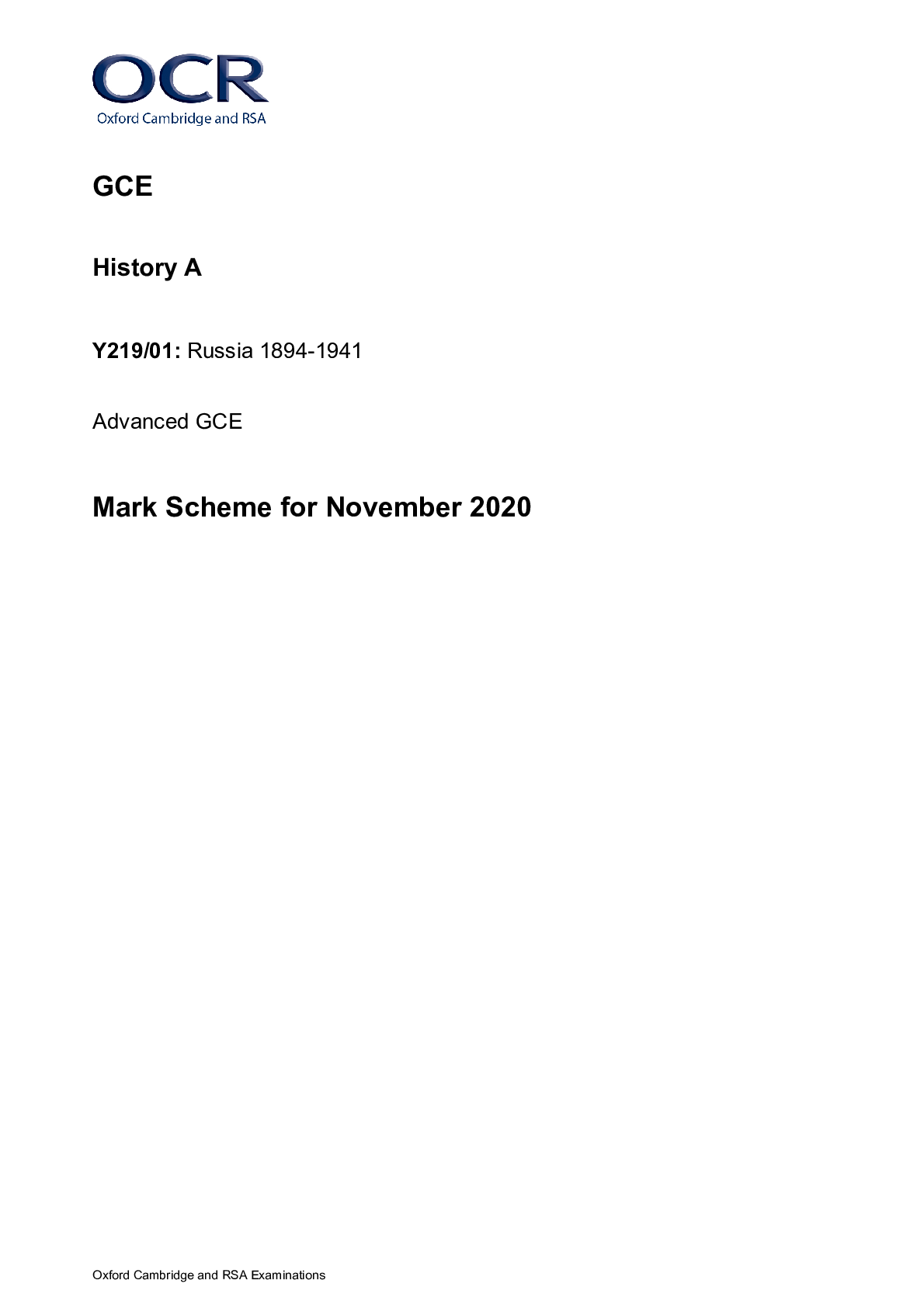
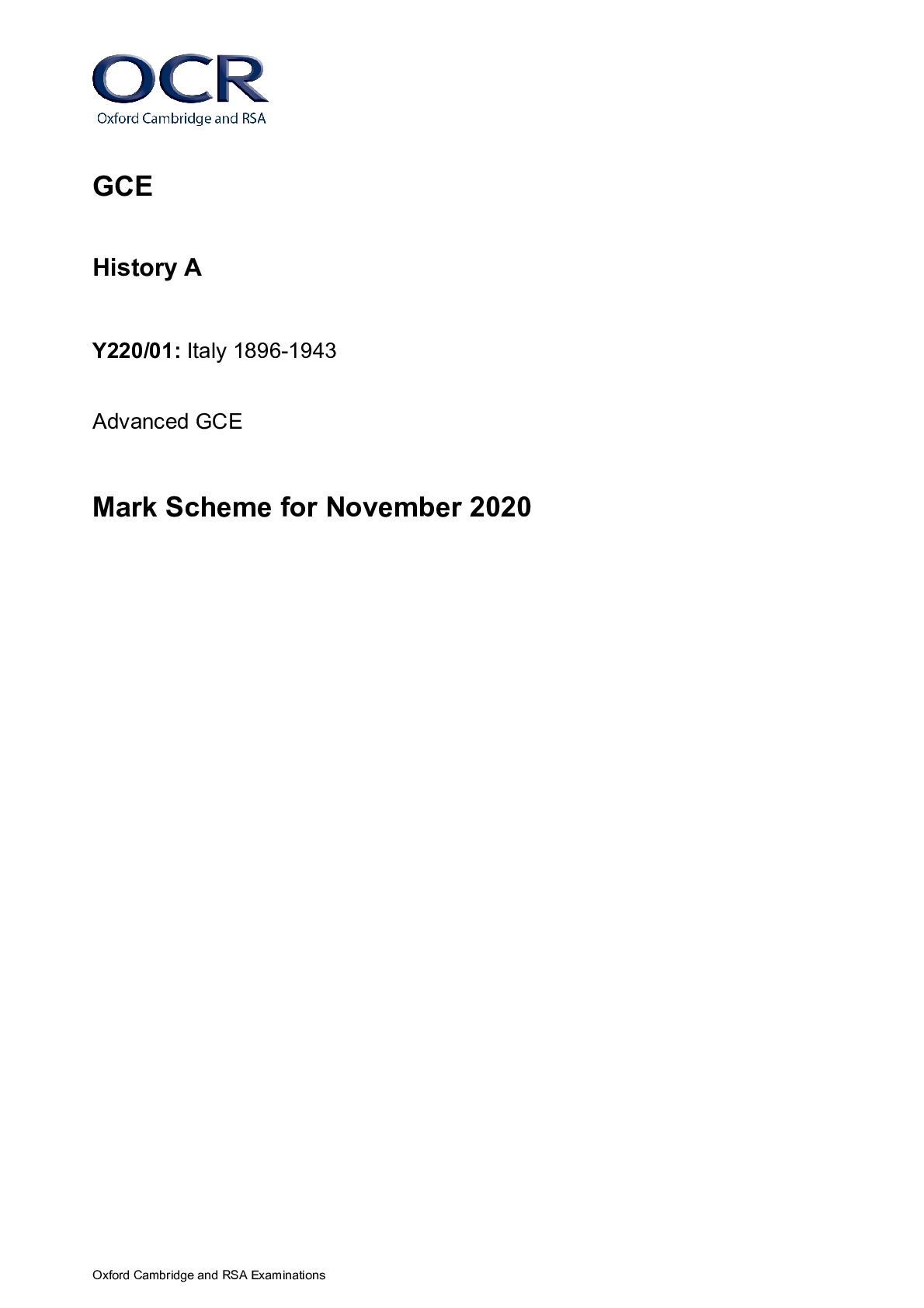

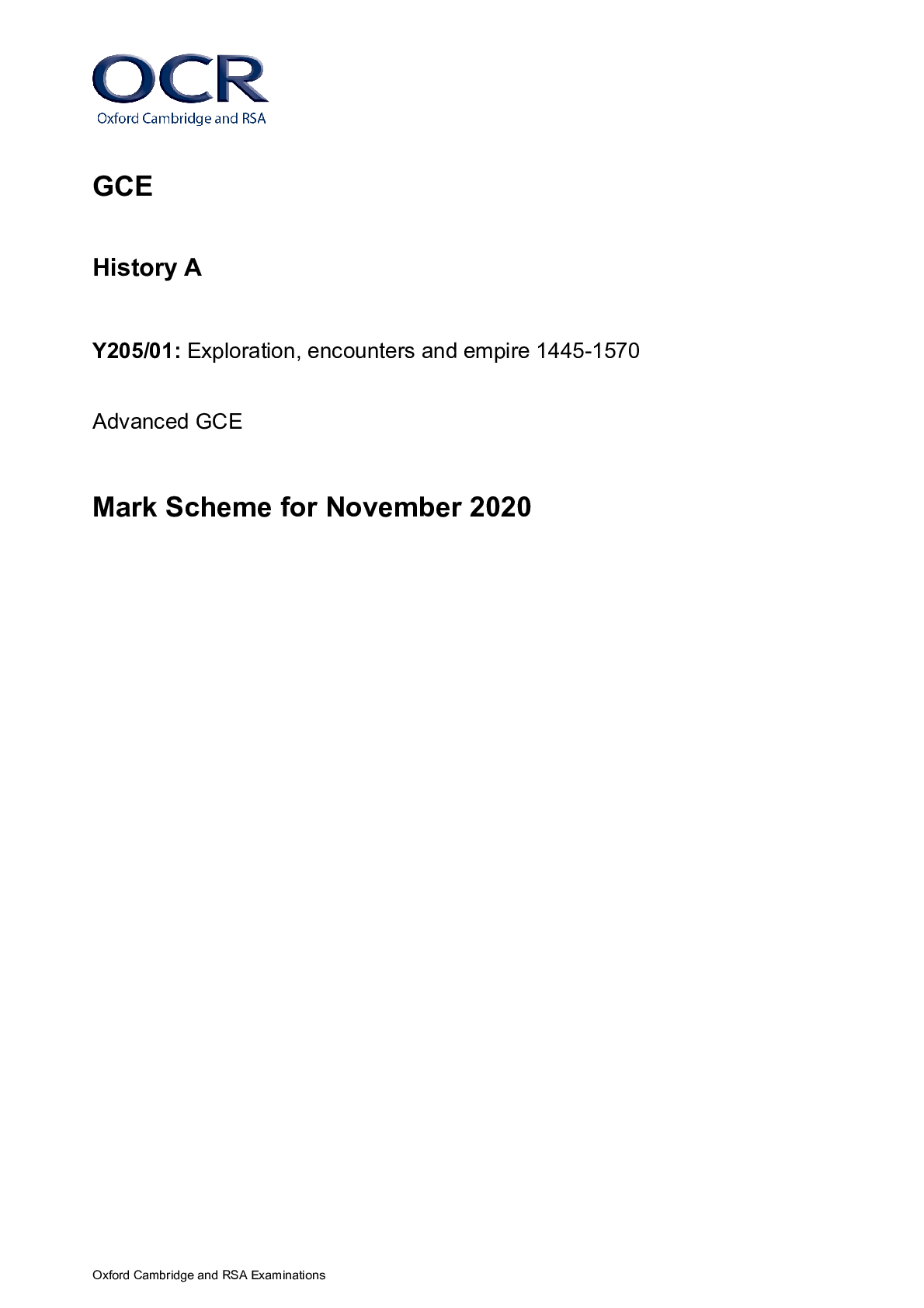
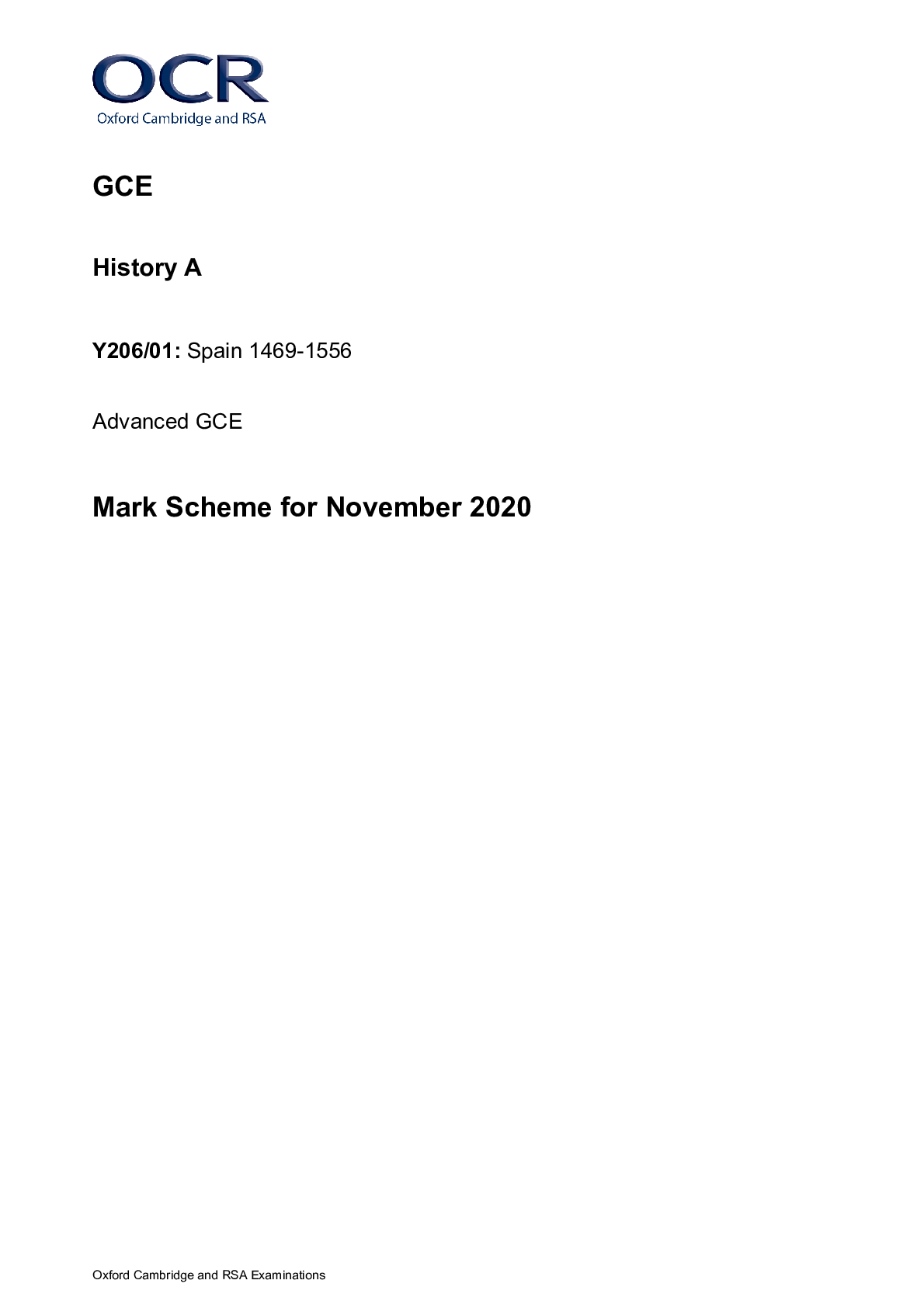
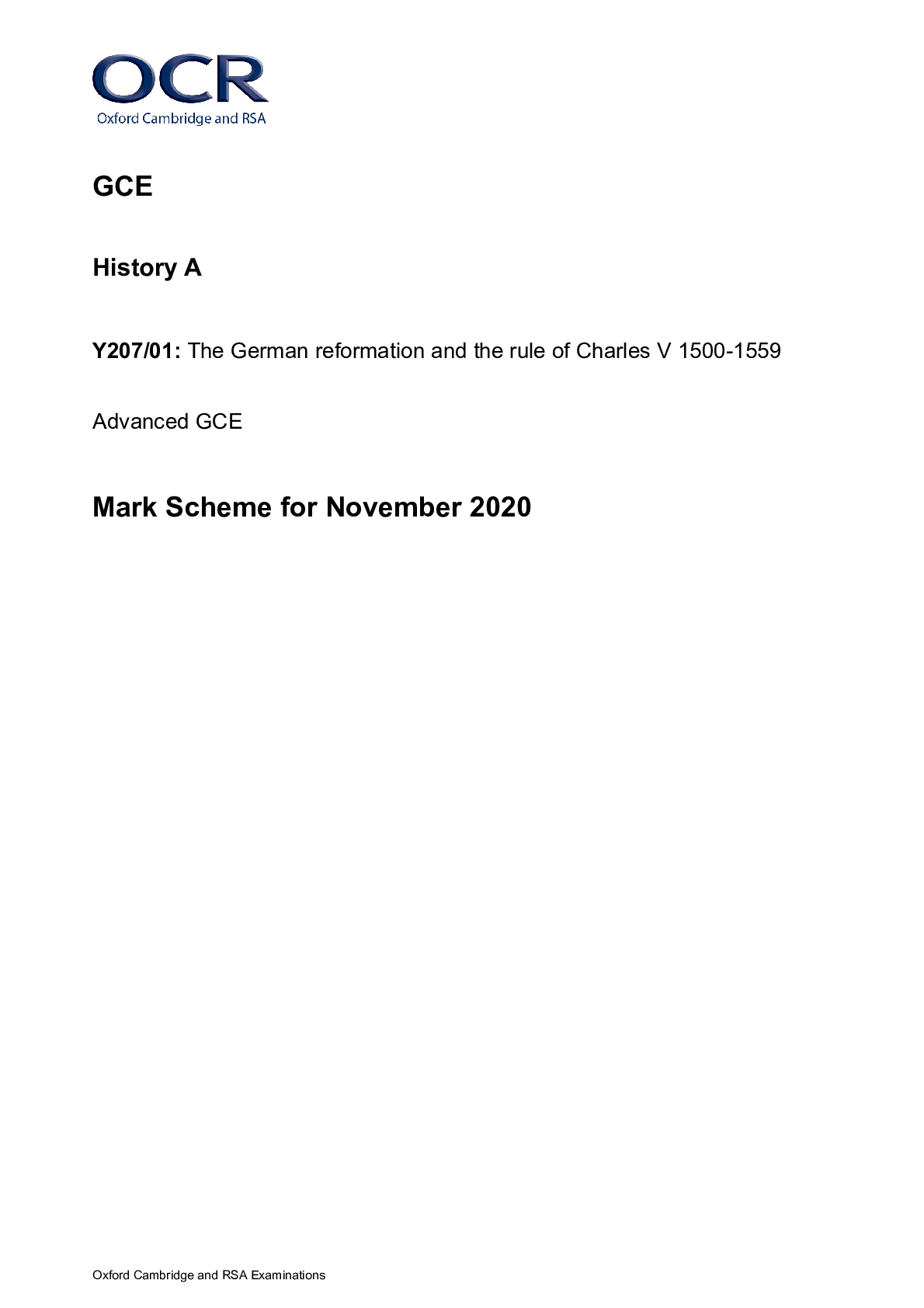
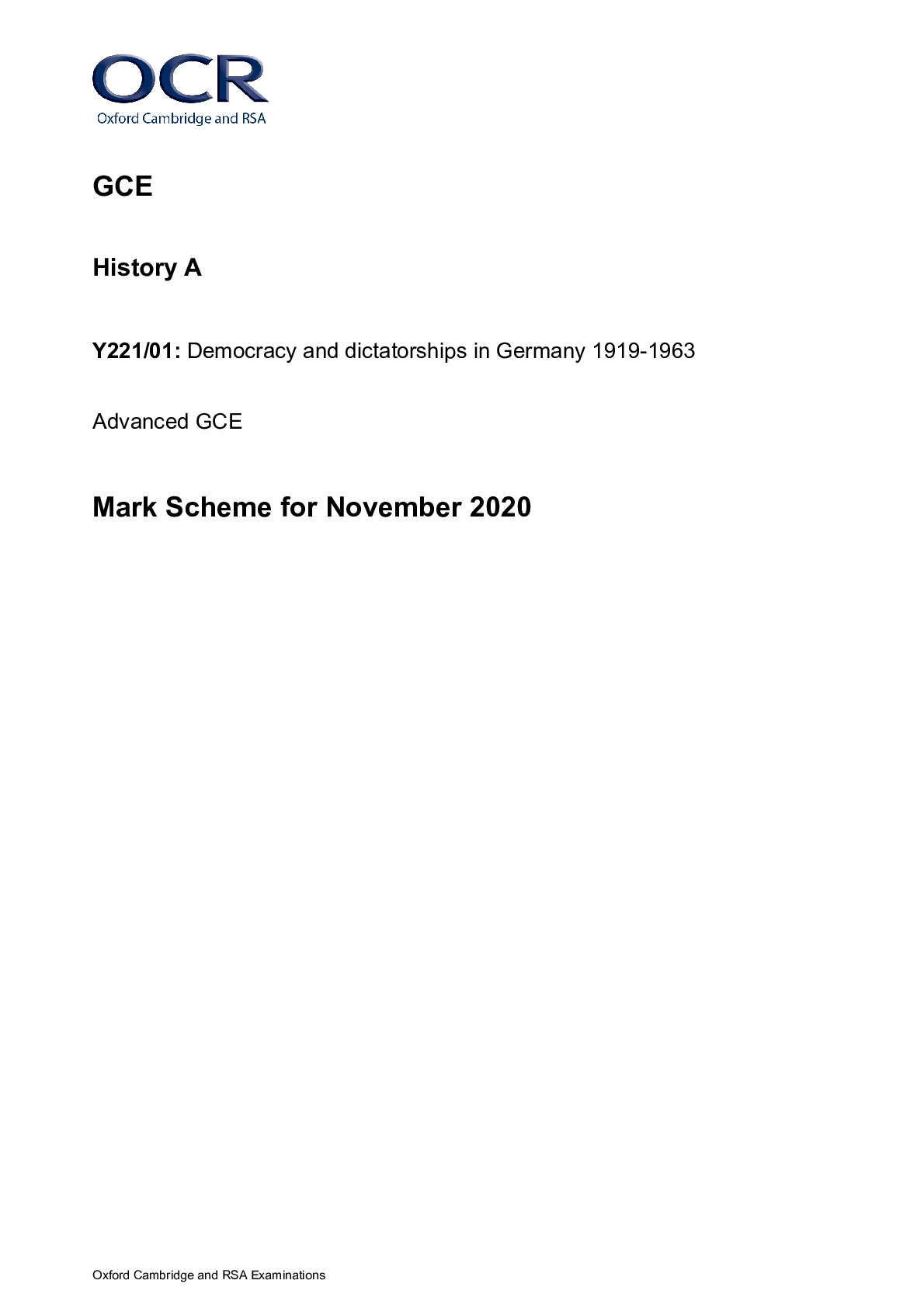

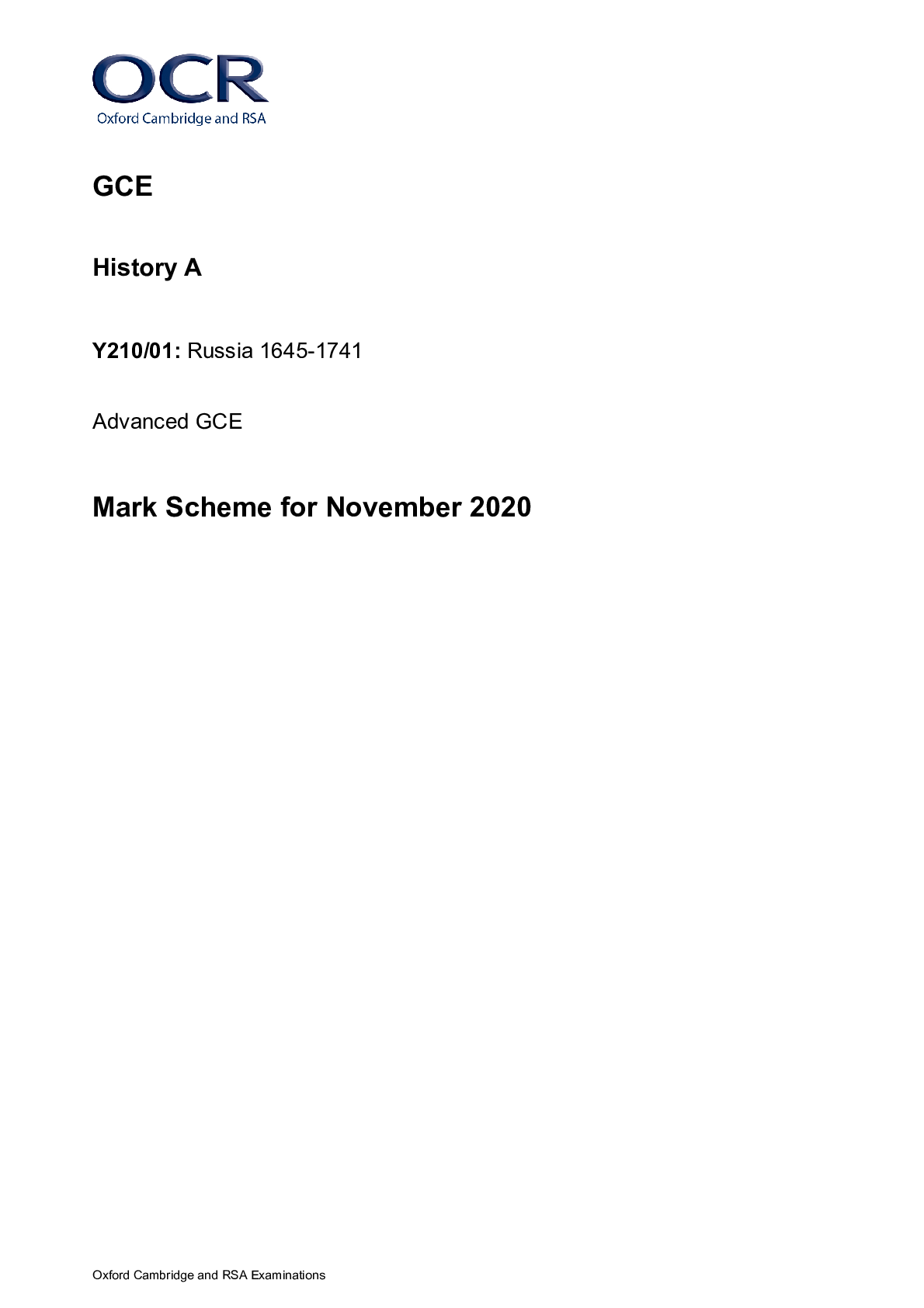


.png)



